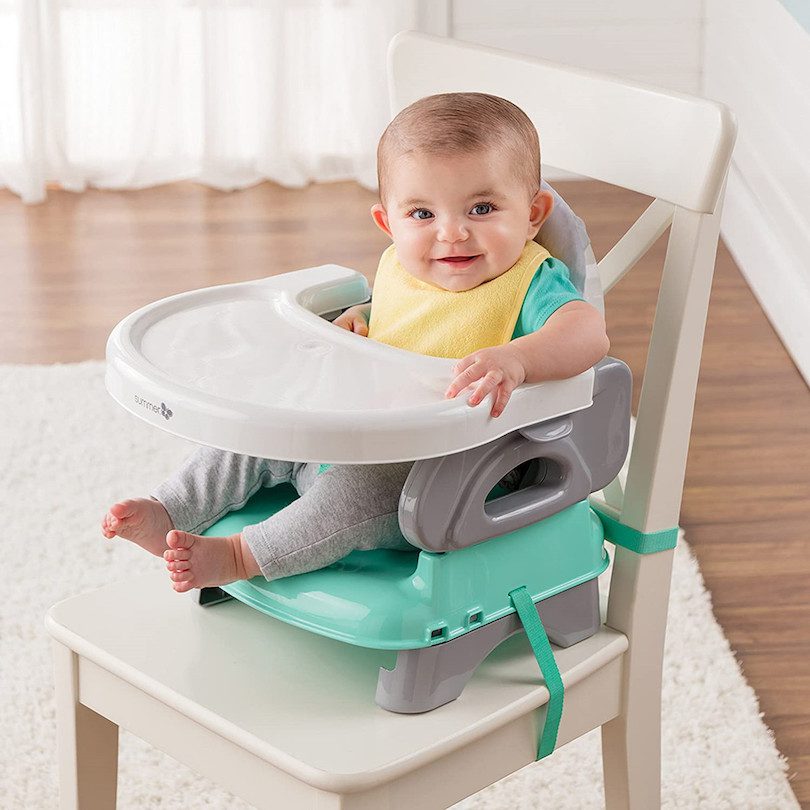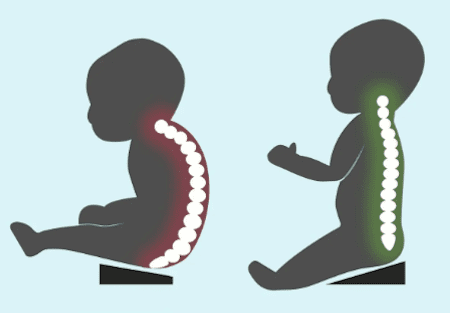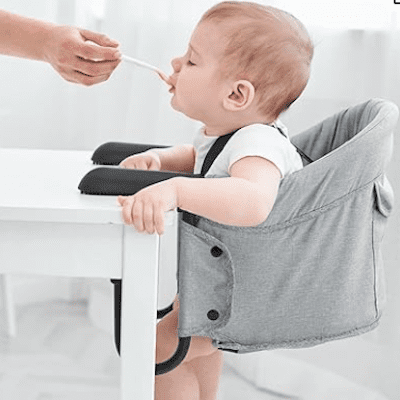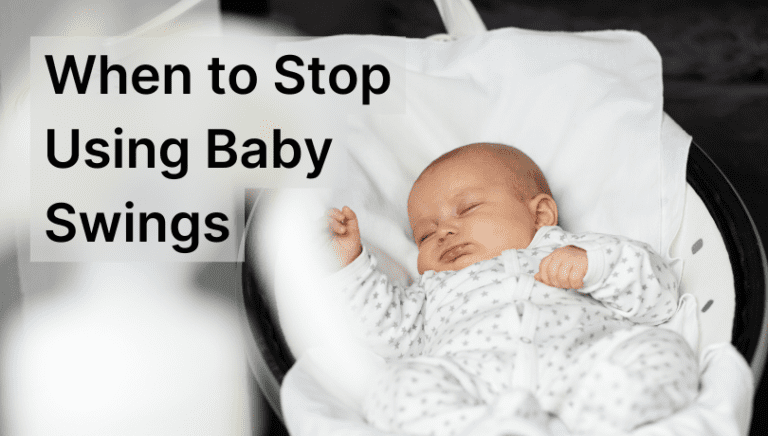High Chair to Booster Seat: When’s the Right Time to Switch?
‘Booster seats boost your interest in meals with the family at the table!’
HAHA! This is what I used to tell my kids when they were in the transition phase from high chair to booster seat.
In fact, it’s really true! A high chair is suitable for introducing your baby to eating solid meals (or the baby-led-weaning process). After a few months, your little one may sit steadily and upright independently. This is when we should welcome BOOSTER SEAT for your child. Being a mom, I have faced the transition period to a booster chair from my most adventurous kid, Aiden, to my most shy kid, ‘Avery’.
You can use a booster seat once your baby gains proper core strength to control its head, neck, and spine without support (at 18 months).

In my opinion, the answer to the question, ‘when to transition from high chair to booster chair?’ is variable. This differs from child to child and depends on their development stages.
Many parents are unaware of the right time to shift to a booster seat for their child. If you are one of them and want to know more about this, you are at the right place! Let’s solve this mystery behind these tiny little seats, guys! Keep reading below for more details.
Also Read: When to Switch to Booster Seats in a Car?
Table of Contents
What Is A Booster Seat For Table?
First Things First! Do not get confused with the booster seats which we use in cars. Those seats increase the car seat height while maintaining the baby’s safety.
Here, we’ll discuss TABLE BOOSTER SEATS for growing children. I’m attaching an image of the booster seats below.

Now, let’s start with the basics.
When To Use High Chairs?
As we know, parents start using high chairs when their baby is 4–6 months old. A high chair supports the baby’s developing neck, trunk, spine, and bum at mealtime. These chairs have detachable food trays too. If you would like to check out my best high chair for babies recommendations, click here to read that article.
Initially, you can feed the little one using the food tray. For older children (above 6 months old), you can remove the tray and pull them closer to the table. This way, the baby’s hands can reach the food on the table. The main purpose of using these chairs is your little one’s safety while sitting.
Your baby’s neck and head wobble in the first 6 months. It may slouch or flop forwards while sitting in the high chair. That’s why many chairs have a reclining seat. The high chair’s 5-point harness and crotch post keep the baby safe while sitting.
When To Transition Your Baby From High Chair To Booster Seat?
Parenting is a TOPSY-TURVY RIDE OF EMOTIONS, BONDING, AND EXPERIENCES!😃
In my case: Theo continued sitting in high chairs until he turned 2. But, Sawyer started sitting in booster chairs when she was 1.5 years old.
We must realize that using a booster chair is not just a fashion or parenting trend. It is an age-appropriate sitting solution for growing children, mainly for toddlers.
I have created a checklist of this for you guys! Know the right time to transition out of high chair into a booster seat when:
1. Child Starts To Sit Upright Independently:
At the infant stage, your baby needs support to balance its body. High chairs offer prominent support to their neck, head, and back. Muscle strength develops in children after a year and a half. Eventually, the baby excels the motor skills to balance their body in the stable sitting position.
In the toddler phase, children gain more core strength for longer sitting and eating meals. Some children also learn to get in and out of the chair safely. Getting out of the booster chair is easier than a high chair. This is when you must consider introducing a booster chair to your little one.
2. When the Child wants to be Independent For Sitting
When a baby grows into a toddler, it also develops a sense of self, freedom, and own opinions. I have observed that many children, who have developed independent sitting skills, get frustrated or irritated when you make them sit in high chairs. This happens especially after 2 years of age.
Many children learn to navigate their routine, climb independently, and get into a chair without assistance. These are the signs when you should consider shifting your child to a booster seat.
3. When the Child Shows Curiosity for Eating with all the Family Members
It’s a fact that- ‘children observe us all the time!’
Many times they mimic the actions of adults. This happens when they learn how to eat, their height increases, and they identify various foods.
Here’s a nostalgic memory!
My kids used to sit together for meals when at home. The younger children used to see the older ones eating at the table. When Sawyer turned 2, she used to jump and climb beside her booster seat chair to sit with her siblings and babble, ‘I wanna eat too Mumma!’ 😄
After sitting in her booster seat, she used to ask questions about the food being served! All of us used to laugh at her innocent questions and curiosity!
Well, this is a COMMON SIGN in the majority of the cases.
They are keen to explore texture, color, taste, and feel in the food. This is a good sign of their sensory development! When your child shows such behavior, you try sitting them in a booster chair for easy access to the table. These seats offer a raised platform to access the dining table while maintaining the support and balance (like in a high chair). This helps the child eat properly without spilling food bites.
Some Factors That You Must Consider Before This Transition:
Here is a list of factors that you must consider before using a booster chair:
1. Age:
Your child must sit independently and stably on the booster seat. It happens at the age of 12–18 months. Some children learn to sit without slouching early, while some learn late.
2. Cost:
The seat in which you are investing should be worth its cost. It should comply with all the basic requirements of a crouch seat post, safety belts, stable base, etc., within an affordable price range. Always go for a booster seat manufacturing brand that follows all safety compliances by CPSC (United States Consumer Product Safety Commission). If you have multiple children, you can use the booster seat for younger kids, which you used for older kids.
3. Your Child’s Readiness:
Some children learn to walk and talk early. They can tell their parents about their sitting choices. But, some are not that mature enough to understand the safety parameters. For example, if your child pushes the chair while kicking its legs to the table, it can fall on the floor.
You must identify your child’s readiness to sit in these seats. For better safety, keep the booster seat on the floor first and give them food to eat. After a while, you can try placing the same booster seat on a dining table chair.

I had this experience with Theo. I used the ‘Upseats Baby Floor Seat Booster Chair’ to introduce him to eating at the table. It encouraged upright sitting positioning for Theo and trained him for eating at the table.

Initially, we used to make him sit on the floor seat. Later, as he got used to sitting in this booster seat, we shifted to a chair booster seat arrangement at the table.
Safety Tips While Using A Booster Chair For Your Child:
- Introduce your child to the safety harness and straps. Toddlers love to explore these things. They may loosen it while handling. Teach them how to use these safety straps properly for a stable sitting position.
- Choose a booster seat according to your child’s weight, height, and age.
- Read the manufacturer’s instructions clearly and fix the booster seat properly on the chair. Move it to check the straps’ firmness
- Do not allow the child to stand on the booster seat. A slight unbalance may lead to a fall or slip accident.
- The chair you use to tie the booster seat must be sturdy enough. It should have a hard backrest. The chair’s legs must not slip or wobble when the child sits.
- Ensure the table is not tipping over due to weight imbalance when you use hook-on-booster seats.

- Even though your baby has started sitting independently, always be closer to your little one sitting in a booster seat at the table to avoid choking or tipping over incidents. Keep an eye on the child to ensure a snug fit harness for comfortable eating.
Common Mistakes To Avoid When Transitioning In Booster Seat:
I have seen major sweet and sour movements of the booster seat transition period in my kids. We failed, we learned, and we grew forward! That’s the beauty of parenting!
Here are some common mistakes that you can avoid when you are transitioning your child from a high chair to a booster seat:
1. Making your child sit in a booster seat against its will
Many children reach the physical developmental milestones for introducing a booster seat. Sometimes, many children are not EMOTIONALLY ready.
Yes, that’s true! Introducing a booster seat to children is a new sensory feeling for them. It seems like a small change for us. But for kids, IT IS A BIG DEAL. They may or may not like this change.
Here’s what you can do:
DO NOT FORCE your little one until he/she is ready to adapt and accept the booster seat. This is a part of GENTLE PARENTING! Forcing them to sit in these seats before they are ready may lose their interest in eating food with everyone at the table.
Give your child some time to get used to this change, let them explore this seat in their own way (of course while keeping them safe from falling and tipping hazards), and go with their PACE.
Do not RUSH and go by your little one’s will.
2. Directly using a regular chair:
The ideal sitting position arrangement at a table for a growing child is like this:
-First High chair (from minimum 3–12 months of age),
-then Booster seat (from min. 12–18 months age),
-and lastly Regular Chair (from above 5 years of age)
Your child may not sit at the right height at the table. Your little buddy may not get the proper support for stable sitting (which is available in a booster seat).
Here’s what you can do:
Supervise your child’s development stages, identify their signs of readiness for transition, and DO NOT SKIP THE BOOSTER SEAT step.
Use booster seats until your child is in the toddler phase. They are designed for their safety and natural postural developments.
If you see any delay in development stages, consult a pediatrician for right guidance.
3. Over-instructing the child for booster seat rules:
Your child is NOT likely to follow the rules if you instruct them excessively. Overburdening them with many regulations may put them under mental pressure. It may lead to frustration and tantrums.
Toddlers have a short attention span. They may listen to a few rules initially as you start talking. But if you talk about 10–20 rules at a time, their mind is already at another sensory activity after the first 3–4 rules!
Here’s what you can do:
Go slow!
They say, ‘ The journey of a thousand miles begins with a single step!
Introduce one rule at a time. Your child will understand the possible hazardous situation and automatically follow the instructions. Also, let them make mistakes that are within safety limits. They will learn on their own. For. e.g. To sit properly in a booster seat at the table, not to kick the table, etc.
FAQs:
What Is The Age Range For Using Booster Seats At The Table For Eating?
Ideally, if your child is ready to sit upright without support, you can start at the age of 18–24 months (minimum). Parents can use these seats until your child turns 5 years old.
What Are the Advantages Of Transitioning To A Booster Seat At Table?
The booster seat offers the ideal height for a child to join the family at the table. It is more convenient and less restrictive than a high chair. Also, it is easier to clean than a high chair.
Conclusion:
Ideally, the right age to shift your child from a high chair to a booster seat is 18–24 months. These seats are not only age appropriate, but they are cost-effective, portable, lightweight, and sturdy. The main purpose of using these seats is to make your growing toddler learn about family mealtime and basic table etiquettes. Their snug fit harness protects the child from slouching and slipping forwards.
I suggest always taking guidance from a parenting expert or pediatrician before transitioning in these seats. I hope you have gotten all the A-to-Zs for the right time to transition from a high chair to a booster seat for a child.
If you have a toddler at home and want to make mealtime friendly and enjoyable, Booster seats are the SOLUTION. Email me if you have any questions about these fantastic seats. I am always here for you guys.
Until then, happy parenting.






